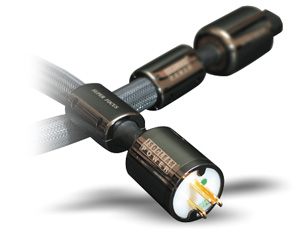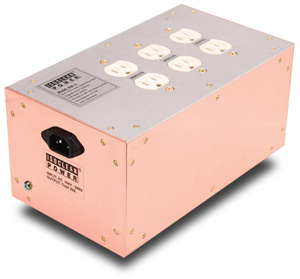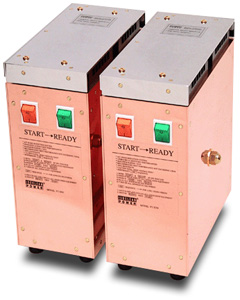 |
||||
| June 1, 2005 Isoclean Super Focus Power Cord, Isoclean 80A3 Filter, Isoclean PT-3030G II Isolation TransformerP.C.
Now and then, the politically correct stance rings true. Carpets excepted, it’s no longer cool to refer to things Asian as Oriental. The issue is one of centrality. The Orient is the East. Indeed, but east of what? Of where it’s at? Is the Occident where the world’s hub turns? If anyone persists in thinking so, at least with respect to commerce and industry, it’s a perception that doesn’t bear scrutiny. Within our narrow scope, Asia embraces the world’s dominant manufacturers of consumer electronics. We also understand that Japan, for example, produces high-end A/V goods of exemplary quality. However, when we think of China, outsourcing comes to mind: design it here, make it there. Hong Kong as a locus of audiophile endeavor, execution and design, arrives as a surprise. And so departs an assumption -- at the speed of sound. Staggered over a stretch of weeks, Brian Ackerman of Aaudio imports (the double a is no typo), Isoclean’s US distributor, proposed sending me a pair of the Hong Kong manufacturer’s top-of-the-line power cords, a filtered power bar (what I’d call a line conditioner), and an isolation transformer that operates with the filter, with its associated power cords. If I were to cover everything Isoclean makes, I’d have to be under house-arrest: five grades of power cord, a speaker cable, five filtered power bars (line conditioners), five unfiltered power bars, gold-plated wall outlets, tiptoes, tiptoe saucers, speaker-cable stabilizers, power-bar isolators, a component-isolation platform, dummy RCA and wall plugs, gold-plated fuses, disc cleaner, and audio-grade electrical panels. These folks haven’t been pussyfooting about the premises.. Oh, what gorgeous goods! Two Super Focus power cords ($1800 USD each) were the first Isoclean products to arrive. The items pictured in Isoclean’s catalog appear to be built to an elegantly finished, super-sturdy standard. The photo of the very heavy yet remarkably supple Super Focus cord cannot do it justice. It would look at home in Harry Winston’s window. As to its heft, the catalog explains that the terminal fittings are wrapped in "high quality copper RF shields and . . . custom-designed cable stabilizers"; i.e., thick metal collars just over an inch away from the AG male and IEC female plugs, likewise encased in thick, glossy metal. The conductor, "European 6mm2 copper cable," lies under "three layers [of] nylon anti-static and two layers of heavy-duty copper shields." Modifications to the Wattgate terminations include 24k-gold plating, with contacts "polished to increase contact area" and reduce noise. The virtues peculiar to European copper elude me. I’m also puzzled by what 6mm to the second power means. Altogether, the handsome catalog’s texts could use a tad more clarity. Anyway, the power cords look sensational, and, as you’ll see below, cost a great deal -- as many high-end power cords do. But we don’t listen to pulchritude or price tags. I’ve been happy with the Harmonix Studio Master power cords specifically designed to operate with my Combak Reimyo ALS-777 line conditioner (and other Reimyo electronics). For now, the Isoclean Super Focus power cords will replace the Harmonix cords servicing the ALS-777 and a Mark Levinson No.390S CD player. (An oft-repeated note: The captive power cords of my ML No.33H mono amps go directly to dedicated FIM 880 wall outlets. There’s no preamp in the system.) Cuddling in the sweet spot Studio Masters out, Super Focus in. A first impression is anything but ambiguous. However, we audiophiles understand -- or should -- that Audiophilic Euphoria, known also as Early Onset Hysteria, follows Adenoid Envy in The Head-Shrinker’s Reference Guide. Rather than trust myself unquestioningly, I enlisted the help of a friend, Elissa, who’s been to our place a number of times, loves music, is familiar with the sound system, and isn’t hearing-impaired (the last claim is one I can’t make for a few of our chums). Like me, Elissa marveled at the cords’ appearance. To keep things as objective as possible, I expressed no preference, suggesting rather that a product’s obvious eye appeal may simply be its manufacturer’s way of upholstering the bottom line. My little exercise in cynicism got nowhere. The disc that nailed me likewise worked its mojo on Elissa: Jeremy McCoy & Friends’ Dialogues with Double Bass [Bridge CD 9163]. Rossini’s charming Duetto per violoncello e contrabasso occupies the first three tracks. We concentrated on track 3, Allegro, playing it several times during the power-cord swaps. With the Isocleans in place, Elissa said she was hearing a better sense of definition and space. (Me too.) She couched her impression in an interesting way. She described the Harmonix Studio Masters as contributing to a sound she was rather more accustomed to -- a comfort factor figured into her assessment. She heard the Isocleans as something else again. She said that they elevated clarity to a degree she found startling, a difference it took her some moments to adapt to. Before Elissa’s visit, just after installing the Isocleans, I’d jotted down the comment, "It’s as if a mechanic removed an obstacle from the fuel line." I’ve been hearing a heightened sense of space and definition, no question, but superb instrumental timbres figure in this too, along with a keener sense of snap, crackle, pop, and thunderclap-kaboom. For Elissa’s next test, I played 6000o Kelvin, a well-recorded, richly textured, warmly recommended improvisational mélange with Arto Artinian, flute; Antoine Roney, tenor sax; Adam James Wilson, seven-string violin and fretless guitar; Jonathan Vincent, piano; and Tatsuya Nakatani, percussion [Stone Quarry SQR 0003]. Given the music’s complex, jack-in-the-box randomness, it took a little longer for Elissa to discern a difference between the Studio Masters and Super Focus Isocleans, but there it was, essentially the same: a better-defined, more clearly drawn space. I had until this moment kept my opinions to myself -- Elissa was as close to uncoached as I could manage -- but this time I concurred aloud with her judgment. We agreed that power cords can make more than a marginal difference in how a system plays. To say that Elissa was surprised understates the case. Nor can I strike postures as an old China hand -- I’ve been at this comparison business a lot longer than she, and it blows my mind too. Moving right along The handcrafted, six-outlet -- and gorgeous! -- Isoclean 80A3 filter or line conditioner ($3500) was on the premises by the time of Elissa’s participation, but I hadn’t yet set it up. Let’s linger at gorgeous. As a matter of personal taste, I’m put off by audio gear that aspires to opulence by way of gold-plated knobs, escutcheons, etc. Like the Super Focus power cords, the 80A3’s swank addresses function. According to Isoclean, its sumptuous copper walls serve electrical ends. As with the power cords, gold plating occurs at contact points only. In this strikingly handsome piece, form follows function. The day following, I replaced the Reimyo with the 80A3, the topmost of Isoclean’s three six-outlet filters (rated, respectively, at 80A, 60A, and 50A handling capacity). The catalog doesn’t say much: "[Separate and independent] ultra-low-impedance audio-grade dual 80 + 80 AMP RF . . . Rhodium-plated Furutech IEC socket . . . thick high-quality copper plates for mass, unit stability and efficient [airborne] harmful RF absorption . . . audio-grade national 24k gold-plated AG sockets . . . contacts . . . polished to increase contact area . . . AG sockets wired individually to the IEC socket and [damped] by selected European [epoxy] compound . . . ." Again with European! I also removed the Reimyo’s SRA Ohio Class isolation platform -- the line conditioners would be compared without benefit of external isolation. And I pulled the three standalone Quantum pods I stuck under the cabinet on which the player sits. I thought this a prudent move, since the Reimyo features Quantum’s Quantum Resolution Technology (QRT). I also removed the two Walker UHD Links at the Wilson Audio WATT/Puppy 7s’ upper binding posts. Everything else remained as was: SRA platforms under the ML No.33H amps and No.390S player, Audio Magic Clairvoyant speaker cables and their NotePad isolation pillows, one pair of Nordost Valhalla balanced ICs -- and, of course, the two Super Focus power cords, this time linking the wall to the 80A3 and the 80A3 to the CD player. At this early stage in the listening sessions, both No.33H captive power cords remained at their respective FIM 880 wall outlets. I played a great many discs. Couldn't tear myself away. Holographic doesn't quite describe it. I've never seen a hologram I mistook for the object it represented. Illusion of palpability comes closer. The line conditioner and power cords servicing the CD player alone elevated the system’s performance. The stereo image impressed me as larger and better integrated in terms of width, depth, and height, but in no way unnaturally so. The next step I’d played enough CDs to convince myself that I was a recovering AE (Audiophile Euphoriac) in good standing -- in other words, capable of making rational and possibly even accurate judgments. Now I was obliged to run the entire system, CD player and amps, from the Isoclean 80A3. My sense of apprehension was not unreasonable, nor, I was soon to discover, without substance. My two Mark Levinson No.33Hs, as mentioned, were drawing their power from dedicated FIM 880 outlets. The 80A3 was plugged into a third dedicated FIM 880 outlet. Each 200-pound, mono No.33H, like its big brother, the 400-pound, mono No.33, has its own "AC mains regeneration," which provides an "absolutely pure and stable DC power supply for all voltage gain stages" derived from "our own pristine 60Hz sine wave," thus isolating "sensitive voltage gain stages from . . . AC interference," a feature that "renders any external power conditioning device useless," which is "just as well, since there are no such devices in existence that have the capacity to supply adequate power to these amplifiers." I would not have quoted from Madrigal’s prose were the information irrelevant. My test disc, a recent Deutsche Grammophon 20/21 Series, features the music of a Korean composer, Unsuk Chin, performed by the Ensemble Intercontemporain, the stellar French new-music band. Track 10 of Double Concerto [DG 477 511-8], for piano, percussion, and ensemble, reveals Chin as a meticulous and dramatic colorist. The music is fascinating in its glittering range and detail -- and quite perfect for this kind of comparison. With the entire system run from the 80A3, the presentation sounded somewhat compressed and less well resolved. Having found the 80A3 a superior performer with respect to my system’s digital aspect, I’m not sure what conclusion to draw. Running the system off one 20A power line may have had something to do with it. Doubling up on line conditioning may have been another factor. However, the third Isoclean component, the PT-3030G II Isolation Transformer, and the two Isoclean power cords configured specifically for use with the transformer, had yet to be installed. The full dog and pony show At a tick under 60 pounds, the PT-3030G II Isolation Transformer ($2700) isn’t something you tuck under an arm for a stroll through the digs -- hefting it about, I was reminded of what a wuss I’ve become in my dotage. Intended to operate upstream from the line conditioner, the PT-3030G II requires a pair of specially configured Auto Focus power cords ($1300 each): wall to transformer, transformer to filter. Above and below, the piece’s build quality astonishes. Like the Isoclean 80A3 filter, the PT-3030G II’s vertical surfaces are clad in copper plate. Isoclean applies gold where it matters: as earlier mentioned, at the male plugs’ prongs as well as contact points between transformer and its power cords. Ideally, Isoclean would prefer you use a pair of these transformers per filter. The accompanying booklet illustrates three recommended 3030G II applications. Sit back and take a deep breath: "for the music lovers" -- in other words, the aesthete on a budget -- one 3030G II feeding one filter for preamp and power amp(s), another pair for digital gear; "for the high-end audiophile," Isoclean recommends three 3030G IIs feeding three filters: one for power amps left and right, another for the preamp, the third for the digital gear. "For the ultimate high-end audiophile" to whom funds and/or space offer no impediment, eight 3030G IIs feeding four filters: one each for amps left and right, for preamp, for digital gear. In order to meet a deadline -- a second 3030G II transformer’s arrival and burn-in would have taken too long -- and notwithstanding its manufacturer’s recommendation, I went with one 3030G II feeding one 80A3, both at the service of my sound system’s digital side; i.e., my CD player. The amps remained plugged directly into their respective outlets.
Those of us with pedestrian imaginations usually cannot hear obviously superior construction unless it contributes to an audible difference. The question, as always, was this: Did I hear that difference with the 80A3 in combination with a 3030G II? Yes, and that surprised me. The transformers are represented as particularly effective in dirty electrical environments -- urban settings, apartment buildings, and the like, where EMF and RFI make their presence particularly known. I live in a small town on the coast of Maine. There’s a transformer on the power line just outside my house. Our electrician installed four inside lines for the sound system alone, three of which I’m using. One would think his juice couldn’t get a whole lot cleaner. Perhaps, but the domestic motley occupying outlets both rural and urban may indeed muddy the audio waters, emphasis on may. I’m just a happy-go-lucky listener who writes about what he hears. I’d sooner eat dirt than study in depth the theoretical and practical sides to these matters. For me, differences for the better mean improved resolution, which in turn means better definition, including the low end. These differences need not be night-and-day. For fanatics -- excuse me, I meant audiophiles -- an uptick in performance, however small, warrants a recommendation. Trotting toward a conclusion I took a substantial break from Isoclean-in, Isoclean-out comparisons with the Mark Levinson No.390S player in order to familiarize myself with a component I’ll soon be writing about: the quite remarkable Wadia 861se CD player. After a few weeks of pleasurable, just plain listening to the Wadia, I returned to the 390S-and-Isoclean rig. (Note: I used my review pair of Isoclean Super Focus power cords for both players. Their superiority was early established, I hated the idea of doing without. Returning to the Isoclean ensemble simply meant going from wall outlets to the transformer-filter combo’s inputs.) A just-arrived CD, Acts of Love, with Borah Bergman, piano; Lol Coxhill, soprano sax; and Paul Hession, drums [Mutablemusic 17519-2], was all I needed to confirm earlier impressions. With the No.390S going directly to the wall, this slightly bright and musically irritating recording sounded all right. With the 390S plugged into the Isocleans, I heard an advance in "presence" as soundstage definition and meticulously defined instrumental timbres, along with a clear improvement in dynamic subtlety. My pleasure coasted along through a number of discs, the Isoclean rig conveying a significant touch of magic. In the matter of evaluation, magic is a silly term. And yet, with respect to one’s love of music on a recording, whatever heightens "thereness" adds charm to one’s existence. To bring that down to concrete terms, let’s consider string quartets by Debussy, Ravel, and Dutilleux, performed by the Juilliard Quartet [Sony Classical SK 52544, released in 1993]. The senses of location and harmonic complexity were better than I’d ever heard in this room. Even underrepresented, the Isoclean products worked wonderfully well. Isoclean’s importer would have preferred seeing me with two transformers, as mentioned. I’m sure he’ll be mollified by my more than good impression of the one-filter, one-transformer setup. I can’t possibly return these pieces. My wife may want to kill me, but that’s another story. And I’m saving my pennies for that second transformer. P.S. Brian Ackerman wanted me to check out Isoclean’s fuses, and I’d have liked to oblige had I been able to pull the No.390S’s snugly ensconced internal pair, but I lack the specialized tool. (I believe Marc Mickelson has something to say about the fuses.) Among the Isoclean goods I received were three four-packs of RF Isolators, dummy plugs of gold-plated copper for unoccupied wall outlets and filter inputs, along with a three-pack of metal-and-composite Isotip S1s: "[s]hock [a]bsorb[ing] tip toes . . . constructed of compound materials ranging from very hard, hard and soft . . . to dampen and absorb micro mechanical vibrations" under the transformer. Testing the RF Isolators’ effectiveness is beyond my fragile means. One takes on faith that grunge-bearing vapors are emitted from open outlets and inputs. If you think it’s a good idea to seal off these vacancies, the Isolators are as elegant a means as I’ve seen. The mention of elegance brings us to cost. High-end audiophiles will not be shocked. Nevertheless, I find $245 for three tiptoes and saucers steep. Still, the price is not out of line with similar products. …Mike Silverton Isoclean Super Focus Power Cord, Isoclean 80A3
Filter, Isoclean PT3030G II Isolation Transformer Isoclean Power E-mail: trchk@netvigator.com US distributor: Aaudio imports E-mail: aaudioimports@cox.net
Ultra Audio is part of the SoundStage! Network. |


